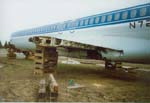Robert Baetke's Images and Text - Thanks Robert!
 |
The airplane was "staged" at the Washington County Fairgrounds
while the salvage crews removed the engines and many of the parts that could
be resold as "flight ready". |
 |
The Boeing 727 has 3 engines. [] Here
the starboard engine has been removed and the center engine is being prepared
for removal. |
 |
The rear stairway of the Boeing 727 was made famous by D.B. Coopers' infamous
escape by lowering the stairs in flight and parachuting out of the plane
with the ransom money he received from the airline. He has never been found
but some of the money washed up on the shore of the Columbia River a few
years ago. Most people believe he did not survive the jump. [], the stairway will be the main entrance to Bruce's
new home. |
 |
After ascending the stairs, this is the view looking forward. To the left
is a head and the aft galley. |
 |
During the salvage operation, Bruce stayed with the plane almost around
the clock for safety and security. |
 |
The interior of the 727 will provide Bruce with over 1000 square feet of
living space once the seats are removed. |
 |
The "Front Office", where the pilot and copilot do their work.
This will eventually be Bruces home office, complete with computer displays
where the instruments are located. |
 |
The pilot's overhead control panel. |
 |
Close-up of the co-pilots controls and instruments. |
 |
The Flight Engineer's console. |
 |
To make more room available inside, the overhead bins had to be removed.
This involved disconnecting the lights, call buttons, oxygen masks, sound
system, and air conditioning. |
 |
Before transporting the airplane on surface streets it would be necessary
to remove the tail section. All three engines have been removed and a ladder
placed to allow Bruce to climb up into the intake tube for the #2 engine. |
 |
Here's Bruce climbing up the "S-tube". The metal vanes are vortex
generators placed on the inside radii of the S-tube to reduce turbulence
within the engine duct. |
 |
He made it to the top! You get a good idea of the size of the airplane by
seeing Bruce hanging out the engine inlet, something you won't see at the
airport! |
 |
The tail has been cut off and the S-tube is lying in the foreground. |
 |
Here's the tail section. The seats were stacked up under the horizontal
stabilizer to keep the tail assembly steady. This was a very cold and windy
week. |
 |
The starboard wing has been cut off and laid on the ground. Notice the tail
section in the background. |
 |
The starboard wing root after the wing was cut off. |
 |
The port wing root after wing removal. Notice that the landing gear has
been retracted and the plane is resting on the cribbing in preparation for
moving day. |
 |
Close-up of the port wing after it was cut off. |
 |
This is what the plane looks like after having its wings "clipped".
This was necessary to transport the airplane over surface streets. The wings
and tail will be re-attached when the plane reaches its final destination. |
 |
Transport cribbing under the nose. |





















